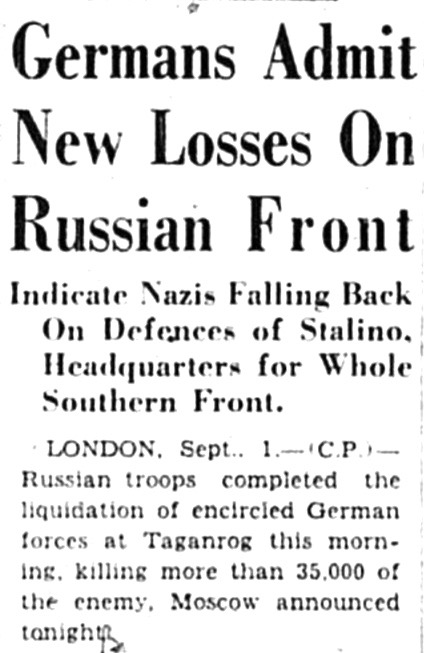Canadian Sailors Prepare for Invasion of Italy
to Begin in Earnest on D-Day Sept. 3, 1943
'Great Aerial Fleets' blast Berlin; Allied navies assemble in Mediterranean,
as well, for the upcoming invasion on the toe of Italy's boot (Sept. 3)
Introduction:
A great deal of information from The Montreal Star, another well-known and proud Canadian newspaper, has already been shared related to the invasions of Italy, including Operation Baytown, in September, 1943, on this site.
Readers can visit the following link - Editor's Research: Invasion of Italy (33) - Montreal Star (Dec. 9-11, '43) - for the most recent entry from The Star as of the date of this new post, and use the Blog Archive in the right hand margin to link to the other related posts if desired. Readers will find a very large collection of newspaper articles, editorials, cartoons and more about the invasions of Italy on various fronts (e.g., Operation Baytown, Operation Avalanche and more), as well as information about the progress of World War II in general.
One of my goals while doing that research (the chief source of material was microfilm stored at the University of Western Ontario, London) was to find more information about the role of Canadians in Combined Operations. These men handled landing crafts in an expert manner (including my father, Doug Harrison, during Operation Baytown, the Allied landings at Reggio di Calabria, on the toe of Italy's boot) and had won significant praise for their tireless efforts in Sicily from General B. L. Montgomery and his Eighth Army, as well their own officers.
In memoirs my father wrote:
Our commanding officer, Lt./Cdr. Koyl gave us the news and said we could now return to Malta and prepare for Italy. In our glee someone shot down the barrage balloon and we said goodbye to the cave, which we had nicknamed The Savoy.
"Dad, Well Done", Page 106
I not only discovered excellent material about the Canadian sailors stationed in The Med (e.g., from the pen of one of The Star's war correspondents, Sholto Watt) but grew to realize that many other stalwart Canadian writers/reporters were also on the scene, some with The Evening (Ottawa) Citizen.
My goal for this series is to present more articles about the Canadians in Combined Operations, Operation Baytown, the 80th Canadian Flotilla of Landing Crafts in particular if possible (my father was a member), and - at the very least - share useful information that provides readers with a wider perspective of WW2, even from a pilot's, soldier's, officer's or lone naval rating's point of view (maybe from the front of his landing craft).
That being said, when I do find articles about Canadians and their landing crafts I will likely enlarge the story by providing good, authentic backup material from other sources (e.g., Navy memoirs, books re Combined Operations). And if I see the words 'Operation Baytown' in a newspaper article I will certainly let you know about it (after jumping up and down). Those words are very rare!
Though we may not read much that mentions Baytown or the 80th Flotilla in the following clippings from The Citizen, we will learn that landing crafts and an armada of other ships were assembling in vast numbers in The Med... from a German radio broadcast. The Allies were spotted but they were not going to be stopped.
As landing crafts and many other ships were assembling off the coast of Sicily, e.g., near Messina, Allied aircraft were hitting Berlin:
The Evening (Ottawa) Citizen

The Allied effort is growing and putting pressure on the Axis on various war fronts:
A hint of the 'Quebec Conference' re Allied leaders?
Rare news from Galt!
At the time the Allied ships were pounding the Italian coast, Canadians were nearby preparing their landing crafts for the upcoming invasion. The 80th Flotilla's landing crafts, after weeks of hard work in Sicily (July), had been taken to Malta for repair and reconditioning during the next month. When word was given in late August, they were driven north to the NE corner of Sicily.
Doug Harrison writes:
Our flotillas beached at the mouth of a now dried up river bed at Mili Marina, then a few days in Catania Harbour* itself, where we had a good view of German low-level attacks on a British cruiser. At night we watched German planes try to take evasive action as they were caught in the searchlights which circled the harbour. During the day we could see the smoke from Mt. Etna.
(*Editor's Note: Mili Marina can still be found on Google Maps, not far south of Messina, but Catania Harbour is much farther to the south, a very great distance from Messina, the location from which father transported materials of war on Sept. 3rd. So, I believe my father meant Messina Harbour, where German planes were much more likely to be spotted, along with British cruisers, mentioned in the news article above).
"Dad, Well Done" Page 113
The article continues:
News from Dover, and somewhere in France!
German leaders think wrong, at least about the coast of France:
A fine report follows by Canadian war correspondent Ross Munro. He details the fine work of the Canadian infantry in Sicily, where they became know as the 'Red Patch Devils.'
Armadas of landing craft can mean many things: an invasion is near or a practice exercise will soon be underway; troops are busy checking weapons and ammunition one last time; materials of war are packed to the gunnels and Canadian sailors in LCAs (landing craft, assault) and LCMs (landing craft, mechanized) are ready to start their engines.
And Doug Harrison will soon realize he is not in Catania, he is in Messina with 50-plus other members of RCNVR and Combined Operations, and is one day away from skimming across the strait that separates Sicily from Reggio:
There may have been a practice exercise or operation on the southern coast of Britain in September, 1943. But the invasion of Normandy was nine months away. Only hours away, however, was the invasion of Italy, specifically at Reggio di Calabria, on the toe of the boot. What was reported by Axis radio commentators? Quite a bit:
And now, a word from our sponsors:
More news as found in The Ottawa Citizen, with an invasion less than a day away:
A very timely cartoon by an unknown artist. Men in small crafts surely flinched a few times when British 'big boys' pounded the Italian coast in order to soften resistance:
"Troops in Sicily Watch' the shelling, as does everyone for miles around:
Men and women in overseas service sure liked getting mail. Meat pies and bottles of gravy would be another matter:
Canadian women join the RCN's Women's service and soon thereafter land in Britain.
(*Editor's Note: Mili Marina can still be found on Google Maps, not far south of Messina, but Catania Harbour is much farther to the south, a very great distance from Messina, the location from which father transported materials of war on Sept. 3rd. So, I believe my father meant Messina Harbour, where German planes were much more likely to be spotted, along with British cruisers, mentioned in the news article above).
"Dad, Well Done" Page 113
The article continues:
News from Dover, and somewhere in France!
German leaders think wrong, at least about the coast of France:
A fine report follows by Canadian war correspondent Ross Munro. He details the fine work of the Canadian infantry in Sicily, where they became know as the 'Red Patch Devils.'
Armadas of landing craft can mean many things: an invasion is near or a practice exercise will soon be underway; troops are busy checking weapons and ammunition one last time; materials of war are packed to the gunnels and Canadian sailors in LCAs (landing craft, assault) and LCMs (landing craft, mechanized) are ready to start their engines.
And Doug Harrison will soon realize he is not in Catania, he is in Messina with 50-plus other members of RCNVR and Combined Operations, and is one day away from skimming across the strait that separates Sicily from Reggio:
There may have been a practice exercise or operation on the southern coast of Britain in September, 1943. But the invasion of Normandy was nine months away. Only hours away, however, was the invasion of Italy, specifically at Reggio di Calabria, on the toe of the boot. What was reported by Axis radio commentators? Quite a bit:
Editor's Note, re the last three paragraphs: Though the "second amphibious force (that was) assembling in Britain" may have gathered for a training exercise, "the presence at Gibraltar of two battleships, four aircraft carriers, etc." may have been the armada of Allied ships (or part of) destined for Italy and the landings at Salerno, beginning on September 9th. And what about the third armada at Messina, Sicily? Not spotted by German intelligence?
The article continues:
Speaking of the third Allied armada, set to depart for Italy on September 3rd... have a Coke:
And now, a word from our sponsors:
More news as found in The Ottawa Citizen, with an invasion less than a day away:
A very timely cartoon by an unknown artist. Men in small crafts surely flinched a few times when British 'big boys' pounded the Italian coast in order to soften resistance:
"Troops in Sicily Watch' the shelling, as does everyone for miles around:
Men and women in overseas service sure liked getting mail. Meat pies and bottles of gravy would be another matter:
Canadian women join the RCN's Women's service and soon thereafter land in Britain.
More to follow from The Ottawa Citizen concerning D-Day Italy, September 3, 1943.
Please link to Articles: Four Canadian Sailors Make Headlines (1)
Unattributed Photos GH














































No comments:
Post a Comment